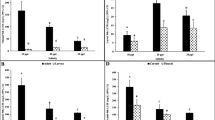Abstract
Oil spill dispersants contain one or more surface-active agents. The surfactant properties that allow dispersants to work are nonspecific and can also affect the lipid-bilayer membranes of living cells. One important parameter used to characterize the physical behavior of surfactants is the concentration at which dissolved surfactant monomers begin to aggregate—the critical micelle concentration (CMC). The CMC can be toxicologically relevant because toxic effects are generally linked to monomers rather than micelles. The CMCs of four different oil dispersants (Corexit® 9527, Corexit® 7664, Nokomis® 3, and Slik-A-Way®) in seawater were measured using surface tension as the indicative metric. From these data, predicted surface tensions were calculated for NOEC and median-effect concentration estimates obtained with the same dispersants for the early life stages of four marine species. In three of the four agents, toxicity to all four species occurred below the CMC; however, in the fourth, toxicity to three of the species occurred well above the CMC. No biologically significant relationship between surface tension and toxicity was noted.
Similar content being viewed by others
References
Abel PD (1974) Toxicity of synthetic detergents to fish and aquatic invertebrates. J Fish Biol 6:279–298
Abel PD, Skidmore JF (1975) Toxic effects of an anionic detergent on the gills of rainbow trout. Water Res 9:759–765
Awad H, Bajahlan A (1991) Effect of two Corexit® dispersants in the removal of Arabian light and heavy crude oils from seawater surface. Toxicol Environ Chem 31–32:49–53
Bartnik FG (1992) Interaction of anionic surfactants with proteins, enzymes, and membranes. In: Gloxhuber Ch, Künstler K (eds) Anionic surfactants: Biochemistry, toxicology, dermatology, 2nd ed. Marcel Dekker, NY, pp 1–42
Bernheim F (1975) A comparison of the effects of sodium dodecyl sulphate and sodium dodecanoic on cell swelling and potassium efflux in a strain of Pseudomonas aeruginosa. Cytobios 14:203–210
Bock KJ (1967) Über die Wirkung der Grenzflächenaktivität auf Fische. Münchn Beitr Abwasser, Fisch Flussbiol 9:110–117
du Noüy PL (1919) A new apparatus for measuring surface tension. J Gen Physiol 1:521–524
Freud BB, Freud HZ (1930) A theory of the ring method for the determination of surface tension. J Amer Chem Soc 52:1772–1782
Gafa S (1974) Studies on relationship between acute toxicity to fish and surface activity of anionic surfactants. Riv Ital Sost Grasse 51:83–192
Gloxhuber Ch, Fischer WK (1968) Untersuchen über die Wirkungen von Alkylpolyglykoläthern in hohen Kozentrationen auf Fische. Fd Cosmet Toxicol 6:469–477
Goldacre RJ (1968) Effects of detergents and oils on the cell membrane. Field Stud 2 (Suppl), Field Studies Council (Great Britain), London, pp 131–137
Harkins WD, Jordan HF (1930) A method for the determination of surface tension and interfacial tension from the maximum pull on a ring. J Amer Chem Soc 52:1751–1772
Lichtenberg D, Robson RJ, Dennis EAW (1983) Solubilization of phospholipid by detergents: Structural and kinetic aspects. Biochim Biophys Acta 737:285–304
Lunkenheimer K, Wantke K-D (1981) Determination of the surface tension of surfactant solutions applying the method of Lecomte du Noüy (ring tensiometer). Colloid Polymer Sci 259:354–366
Mackie AM, Singh HT, Fletcher TC (1975) Studies on the effects of seastar (Marthasterias glacialis) saponins and synthetic surfactants in the plaice Pleuronectes platessa. Mar Biol 29:307–314
Marchetti R (1965) Critical review of the effects of synthetic detergents on aquatic life. Stud Rev Gen Fish Counc Mediterr 26:1–32
Mukerjee P, Mysels KJ (1971) Critical micelle concentrations of aqueous surfactant systems. National Standards Reference Data Series, NBS 36, National Bureau of Standards, Washington, DC
Müller R (1980) Fish toxicity and surface tension of non-ionic surfactants: Investigations of antifoaming agents. J Fish Biol 16:585–589
Mysels KJ, Mukerjee P (1979) Reporting experimental data dealing with the critical micellization concentrations (c.m.c.'s) of aqueous surfactant systems. Internat Union Pure Appl Chem 51:1083–1089
Nagell B, Notini M, Grahn O (1974) Toxicity of four oil dispersants to some animals from the Baltic Sea. Mar Biol 28:237–243
National Research Council (1989) Using oil dispersants on the sea. National Academy Press, Washington, DC
Padday JF, Russell DR (1960) The measurement of the surface tension of pure liquids and solutions. J Colloid Sci 15:503–511
Partearroyo MA, Ostolaza H, Goni FM, Barbera-Guillem E (1990) Surfactant-induced cell toxicity and cell lysis. Biochem Pharmacol 40:1323–1328
Partearroyo MA, Pilling SJ, Jones MN (1991) The lysis of isolated fish (Oncorhynchus mykiss) gill epithelial cells by surfactants. Comp Biochem Physiol 100C:381–388
Scelfo GM, Tjeerdema RS (1991) A simple method for determination of Corexit 9527 in natural waters. Mar Environ Res 31:69–78
Singer MM, Smalheer DL, Tjeerdema RS, Martin M (1991) Effects of spiked exposure to an oil dispersant on the early life stages of four marine species. Environ Toxicol Chem 10:1367–1374
Singer MM, George S, Benner D, Jacobson S, Tjeerdema RS, Sowby ML (1993) Comparative toxicity of two oil dispersants to the early life stages of two marine species. Environ Toxicol Chem 12:1855–1863
Singer MM, George S, Jacobson S, Lee I, Tjeerdema RS, Sowby ML (1994a) Comparative effects of oil dispersants to the early life stages of topsmelt (Atherinops affinis) and kelp (Macrocystis pyrifera). Environ Toxicol Chem 13:649–655
—, —, —, —, —, — (1994b) Comparative toxicity of Corexit® 7664 to the early life stages of four marine species. Arch Environ Contam Toxicol 27:130–136
Author information
Authors and Affiliations
Rights and permissions
About this article
Cite this article
Singer, M.M., George, S. & Tjeerdema, R.S. Relationship of some physical properties of oil dispersants and their toxicity to marine organisms. Arch. Environ. Contam. Toxicol. 29, 33–38 (1995). https://doi.org/10.1007/BF00213084
Received:
Revised:
Issue Date:
DOI: https://doi.org/10.1007/BF00213084




